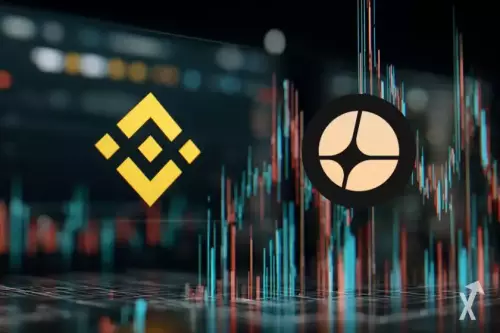 |
|
 |
|
 |
|
 |
|
 |
|
 |
|
 |
|
 |
|
 |
|
 |
|
 |
|
 |
|
 |
|
 |
|
 |
|
代币化存款和稳定币听起来可能是同一件事,因为它们都是链上法币。但它们实际上是不同的概念,这种差异不仅对于用例和我们对区块链潜力的理解很重要,而且对于监管如何发展也很重要。

Aren’t stablecoins and tokenized deposits the same thing? Not at all, argues Noelle Acheson. It’s not just the different functionality and treatment; it’s also the different approaches to money.
稳定币和代币化存款不是一回事吗?诺埃尔·艾奇逊认为,根本不是。这不仅仅是功能和处理方式的不同;这也是对金钱的不同态度。
Tokenized deposits and stablecoins may sound like the same thing, given that they are both fiat-on-chain. But they are actually distinct concepts, and the difference matters not just for use cases and our understanding of blockchain potential, but also for how regulation can evolve. They also both highlight, in different ways, how our understanding of money is changing.
代币化存款和稳定币听起来可能是同一件事,因为它们都是链上法币。但它们实际上是不同的概念,这种差异不仅对于用例和我们对区块链潜力的理解很重要,而且对于监管如何发展也很重要。它们还以不同的方式强调了我们对金钱的理解正在发生怎样的变化。
Noelle Acheson is the former head of research at CoinDesk and Genesis Trading, and host of the CoinDesk Markets Daily podcast. This article is excerpted from her Crypto Is Macro Now newsletter, which focuses on the overlap between the shifting crypto and macro landscapes. These opinions are hers, and nothing she writes should be taken as investment advice.
Noelle Acheson 是 CoinDesk 和 Genesis Trading 的前研究主管,也是 CoinDesk Markets Daily 播客的主持人。本文摘自她的《加密货币现在是宏观》时事通讯,该通讯重点关注不断变化的加密货币和宏观景观之间的重叠。这些观点是她的,她写的任何内容都不应被视为投资建议。
Tokenized deposits, sometimes known as deposit tokens, are blockchain representations of fiat currency bank deposits. They are issued by banks, backed by fiat deposits at those banks, and can run on either private or public blockchains (although, since these are heavily regulated entities, they’ll want complete control of access). In some cases, such as with JPMorgan’s JPM Coin, they are used to settle transactions between JPMorgan clients. In others, such as SocGen’s EURCV, they can be transferred to clients who do not have accounts at the issuer bank, but only after being whitelisted.
代币化存款,有时称为存款代币,是法定货币银行存款的区块链表示。它们由银行发行,由这些银行的法定存款支持,并且可以在私有或公共区块链上运行(尽管,由于这些是受到严格监管的实体,他们希望完全控制访问权限)。在某些情况下,例如摩根大通的摩根币,它们用于结算摩根大通客户之间的交易。在其他银行中,例如法国兴业银行的 EURCV,它们可以转移给在发卡银行没有账户的客户,但只能在被列入白名单之后。
Tokenized deposits boost the efficiency of fiat by eliminating some steps in the execution of trade and settlement, while enhancing transparency and flexibility for their issuers.
代币化存款通过消除执行交易和结算的一些步骤来提高法定货币的效率,同时提高发行人的透明度和灵活性。
Reserve stablecoins*, on the other hand, are blockchain tokens backed by a fiat currency. The issuer, which may or may not be a bank, promises to maintain the value of the token stable relative to the chosen fiat by allowing redemption at any time. (*Other types of “stablecoins,” such as algorithmic and yield-bearing, are different enough to be left out of this consideration for now.)
另一方面,储备稳定币*是由法定货币支持的区块链代币。发行人(可能是银行,也可能不是银行)承诺通过随时允许赎回来保持代币相对于所选法定货币的价值稳定。 (*其他类型的“稳定币”,例如算法币和收益币,都足够不同,暂时不考虑在内。)
This may sound like a tokenized deposit, but it’s not. The stablecoin doesn’t represent the deposit, it is pegged to the fiat value via the backing reserves: a small distinction that makes a big difference.
这听起来像是代币化存款,但事实并非如此。稳定币并不代表存款,它通过支持储备与法定货币价值挂钩:微小的区别却产生巨大的差异。
The difference is operational, conceptual and legal.
区别在于操作性、概念性和法律性。
They do different things
他们做不同的事情
On the operational side, the transfer of a deposit token from one client to another usually triggers an off-chain transfer of fiat from one account to another. The tokens represent bank deposits, so the fiat account balances in theory have to match the token account balances.
在操作方面,存款代币从一个客户转移到另一个客户通常会触发法币从一个账户到另一个账户的链下转移。代币代表银行存款,因此理论上法定账户余额必须与代币账户余额相匹配。
Stablecoins, on the other hand, don’t involve adjusting fiat accounts in the background. They freely change hands between users, and the underlying reserve account doesn’t need to care. It just needs to be available for redemption on demand, it doesn’t matter by whom (this is a slight simplification as not everyone can redeem, but not a significant one – those who don’t redeem can exchange stablecoins for fiat on a number of platforms).
另一方面,稳定币不涉及在后台调整法定账户。它们在用户之间自由转手,底层准备金账户不需要关心。它只需要可以按需赎回,由谁来赎回并不重要(这是一个轻微的简化,因为不是每个人都可以赎回,但不是一个重要的 - 那些不赎回的人可以用稳定币兑换成法定货币)的平台)。
This leads us to the conceptual difference. Deposit tokens are designed to be a more liquid version of traditional deposits, not a substitute. They are not meant to replace fiat money, just make it more efficient.
这导致了我们概念上的差异。存款代币被设计为传统存款的流动性更强的版本,而不是替代品。它们并不是要取代法定货币,只是提高其效率。
Stablecoins, however, are more like a substitute. They were originally created as a way to avoid the need for fiat, back in the early days when crypto exchanges couldn’t get bank accounts. They rapidly became not just a workaround but a more efficient way (faster, cheaper) to move funds to and between exchanges, often preferred even when fiat onramps are available.
然而,稳定币更像是一种替代品。它们最初是为了避免对法定货币的需求而创建的,早在加密货币交易所无法获得银行账户的早期。它们很快不仅成为一种解决方法,而且成为一种在交易所之间转移资金的更有效的方式(更快、更便宜),即使在有法币入口的情况下,它们也往往是首选。
Deposit tokens are created by banks, for bank clients. They represent bank deposits.
存款代币由银行为银行客户创建。它们代表银行存款。
Stablecoins were originally created for those who could not get bank accounts. They are a bank deposit substitute. They represent value, not a commercial arrangement.
稳定币最初是为那些无法获得银行账户的人创建的。它们是银行存款的替代品。它们代表价值,而不是商业安排。
What’s more, stablecoins are bearer instruments: whoever holds them, owns them. They are the asset.
更重要的是,稳定币是不记名工具:谁持有它们,就拥有它们。他们是资产。
Deposit tokens are not bearer instruments. They represent the asset, in this case, named deposits at a bank.
存款代币不是无记名工具。它们代表资产,在本例中称为银行存款。
This brings us to the likely legal evolution of the two concepts. In principle, from the regulator’s point of view, bank deposit representations are fine, bank deposit substitutes are more problematic.
这给我们带来了这两个概念可能的法律演变。原则上,从监管者的角度来看,银行存款陈述还好,银行存款替代品问题较多。
Here is where it gets particularly interesting, and where the two concepts unexpectedly start to blend.
这就是它变得特别有趣的地方,也是这两个概念意外地开始融合的地方。
Here is also where it gets philosophical.
这也是它变得哲学化的地方。
What does that mean for future of money?
这对货币的未来意味着什么?
One of the underlying principles of money is its “singleness”, where a dollar is a dollar (to pick one currency), no matter who holds it or how. This is one of the reasons regulators want to control the issuance of dollars, to guarantee that one of the basic assumptions of monetary law will always hold. In a world with multiple dollar issuers and no central guarantor, perhaps not all dollars would be equal.
货币的基本原则之一是它的“单一性”,即一美元就是一美元(选择一种货币),无论谁持有它或如何持有。这是监管机构希望控制美元发行的原因之一,以保证货币法的基本假设之一始终成立。在一个拥有多个美元发行人且没有中央担保人的世界中,也许并非所有美元都是平等的。
As we have seen, stablecoins don’t always fulfill “singleness.” One
正如我们所看到的,稳定币并不总是满足“单一性”。一
免责声明:info@kdj.com
所提供的信息并非交易建议。根据本文提供的信息进行的任何投资,kdj.com不承担任何责任。加密货币具有高波动性,强烈建议您深入研究后,谨慎投资!
如您认为本网站上使用的内容侵犯了您的版权,请立即联系我们(info@kdj.com),我们将及时删除。
-

- 黄金特朗普,比特币和一个雕像:有什么交易?
- 2025-09-18 18:05:16
- 华盛顿出现了一个持有比特币的黄金特朗普雕像,引发了有关加密货币,金融和特朗普的亲克赖特托立场的辩论。这是未来吗?
-

-

- Binance,CZ和Hyproliquid:加密货币的新时代?
- 2025-09-18 18:00:55
- 探索Binance的影响力,CZ的潜在回归以及超级流动性在不断发展的加密景观中的统治地位。
-

- 杜格供应,稀缺叙事和模因硬币躁狂症:有什么交易?
- 2025-09-18 18:00:30
- 探索围绕门多格供应量减少,稀缺性叙事和模因硬币市场的嗡嗡声,包括潜在的转变和竞争者。
-

-

- Schuyler Police K-9计划:挑战硬币是有理由的
- 2025-09-18 17:59:56
- 发现舒勒警察局如何使用挑战硬币来支持其K-9计划,并有可能将第二只狗添加到部队中。
-

- 通过圈子投资:价格预测更新
- 2025-09-18 17:59:26
- 超流动性(HYPE)违反了市场趋势,这是由于Circle的投资和平台增长所推动的新高度。 $ 100看吗?让我们深入研究分析。
-

- Mymonero Wallet:安全和财务自由的生命线
- 2025-09-18 17:56:43
- 发现Mymonero钱包如何超越其作为加密工具的角色,成为在挑战环境中隐私,安全和财务独立性的重要生命线。
-






























































